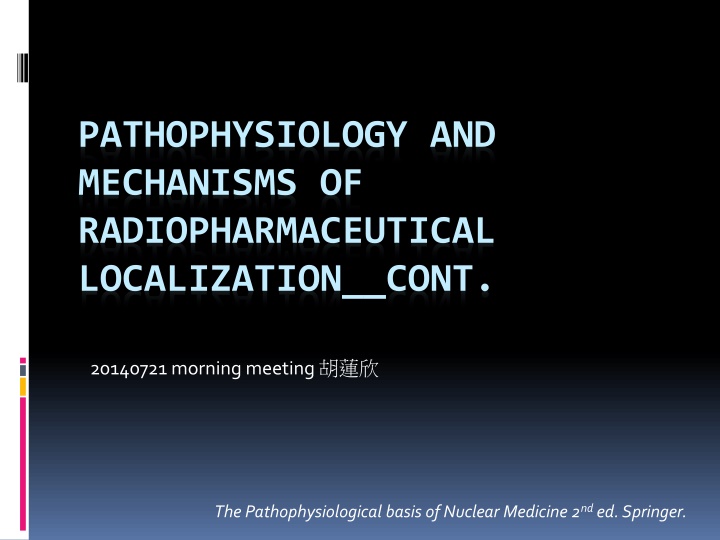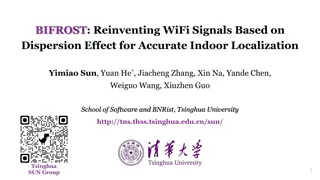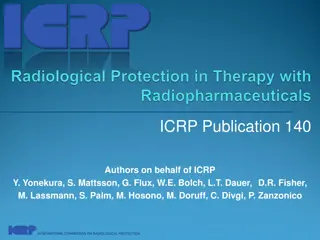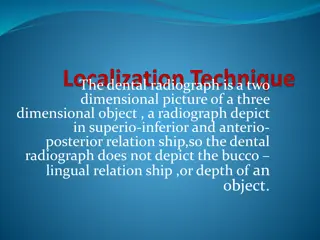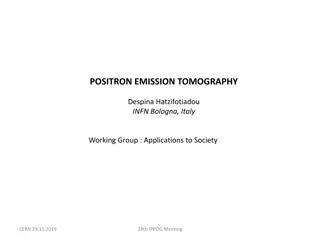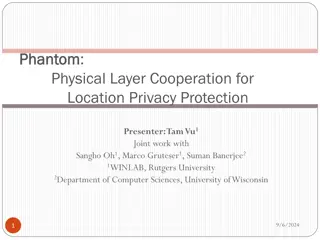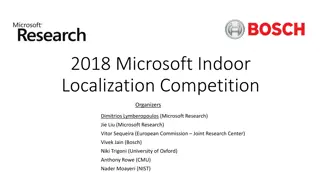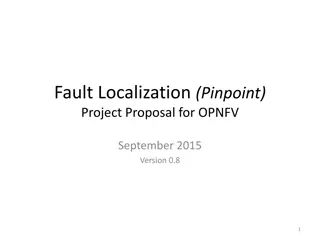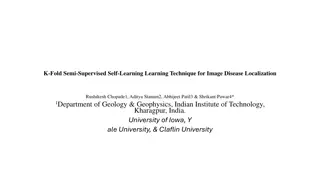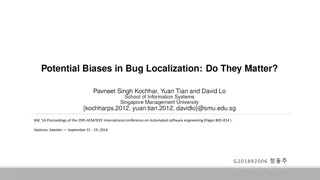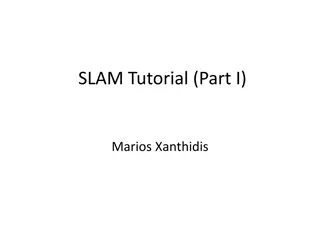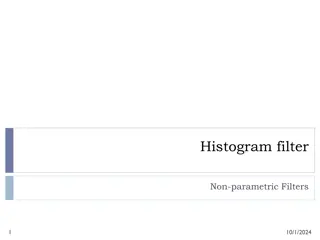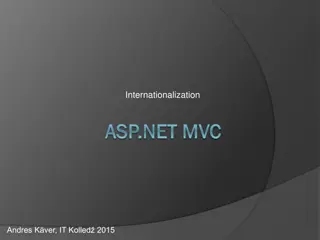Mechanisms of Radiopharmaceutical Localization
The pathophysiological basis of nuclear medicine is explored in-depth, focusing on the mechanisms of radioisotope localization in various tissues and organs. From diffusion to active transport, cellular migration, and receptor-mediated endocytosis, the intricate processes involved in radiopharmaceutical localization are elucidated with a specific focus on Gallium citrate and its binding affinity in tumor cells versus normal cells.
Download Presentation

Please find below an Image/Link to download the presentation.
The content on the website is provided AS IS for your information and personal use only. It may not be sold, licensed, or shared on other websites without obtaining consent from the author.If you encounter any issues during the download, it is possible that the publisher has removed the file from their server.
You are allowed to download the files provided on this website for personal or commercial use, subject to the condition that they are used lawfully. All files are the property of their respective owners.
The content on the website is provided AS IS for your information and personal use only. It may not be sold, licensed, or shared on other websites without obtaining consent from the author.
E N D
Presentation Transcript
PATHOPHYSIOLOGY AND MECHANISMS OF RADIOPHARMACEUTICAL LOCALIZATION__CONT. 20140721 morning meeting The Pathophysiological basis of Nuclear Medicine 2nded. Springer.
The mechanisms of radioisotope localization In vivo, MUGA, RBC scan Isotope dilution Capillary blockade Physicochemical adsorption Cellular migration and sequestration Membrane transport Simple diffusion Diffusion and intracellular metabolism/binding Diffusion and mitochondrial binding Diffusion and increased capillary and plasma membrane permeability Facilitated diffusion Active transport Phagocytosis Receptor-mediated endocytosis Metabolic Substrates and Precursors Precursors: Radiolabeled Amino Acids Tissue Hypoxia Cell Proliferation Specific Receptor Binding Radiolabeled Peptides Steroid Hormone Receptors Adrenergic PresynapticReceptors and Storage 1. 2. 3. 4. 5. MAA lung perfusion MDP bone scan WBC scan, denatured RBC spleen scan Xe-133 ventilation HMPAO/ECD brain perfusion scan Tc-99m MIBI 6. 7. 8. 9.
Diffusion and increased capillary & plasma membrane permeability Gallium citrate: a carrier-free Ga-67 Still nogeneral agreement on the exact mechanisms of localization in tumors Boundexclusively to transferrin: two specific metal- binding sites of the iron-transport glycoprotein Ga- transferrin complex slowly transported through the capillary v. wall or exist as (under physiological pH 7.4) Ga(OH)4-: a soluble gallate ion rapidly leaves the blood compartment and equilibrates with the interstitial fluid (of normal & tumor tissue) gallate:
Gallium citrate Leaving blood vessel Bounded form leaves BV slowly, by transport Free form leaves BV rapidly and equilibrates with interstitial fluid Uptake by normal cells/tumor cells Normal cells: strongly promoted by binding to transferin Tumor cells: simple diffusion of unbounded or loosely bound form of Ga-67 Retention in cells Tumor cell: very much dependent on Ga-67 binding to iron- binding proteins (lactoferin& ferritin, high affinity) prevent back diffusion of free Ga-67 ( unbounded form ) ( unbounded form ) Increased capillary permeability andexpanded extracellular space would augment the transport of the macromolecules (transferrin) across the BV Increased permeabiltiyof tumor cell membrane
Dissociation constant (Kd) vs. Affinity The dissociation constant has molar units (M) The smaller the dissociation constant, the more tightly bound the ligand is, or the higher the affinity between ligand and protein. Kd Kd ( ( ) )
Facilitated diffusion F-18 FDG: facilitated diffusion Glucose: Glucose transporter protein family (GLUT1-6) Hepatobiliary agents IDA derivatives Tc99m disofenin & Tc-99m mebrofenin Blood v. to hepatocyte membrane: -diffuse through pores in endothelium lining -binding to the anionic membrane bound carriers Hepatocyte membrane to intracellular: -facilitated by carrier-mediated, non-sodium- dependent, organic anionic pathways (similar to bilirubin) Intracellular to biliary tract: passive Tc-99m disofenin Tc-99m mebrofenin
Active transport Against concentration gradient Requires energy ATP (primary active transporters) Electrochemical gradient of Na+ or H+ (secondary active transporters) If the energy source is inhibited or removed, the transport system will not function
Radioiodide and Tc-99m pertechnetate anions Thyroid Actively traps certain anions: I-, TcO4-and ClO4- (same pathway) Competitive to each other Only iodine is used to synthesize thyroid hormone; others diffuse out of the gland Affected by iodine containing medications, TSH levels, thyroid & nonthyroid drugs, total body iodine pool Salivary glands, stomach, bowel & GU tract Also significant uptake (secretion) of radioiodide and pertechnetate
Thallous chloride (Tl-201) & Rubidium-82 Tl(OH)2+& Rb+act as K+ion Uptake of myocardium involves (Tl & Rb): Passive diffusion ATP-dependent pathways Uptake by tumor cells (Tl-201) Increased blood flow and increased permeability Na+/K+ ATPase Cellular uptake (Tl-201) Na+/K+ ATPase oubain, digitalis and furosemide Chloride cotransport system furosemid Calcium-dependent ion channel: minimal amount block Addictive blockade effect block
Renal agents Agents for GFR I-125 iothalamate, Tc-99m DTPA, Cr-51 EDTA Mostly filtered by glomerulus No specific transport mechanism involved Dependents on hydrostatic & colloid osmotic pressure Agents for ERPF OIH and MAG3 Partly filtered and mostly secreted by tubules Actively transported by renal hippurate anionic transport system
Phagocytosis Tc-99m sulfur colloid (SC) Size: 0.1-1.0 um Opsonins(specific serum proteins) may interact with it, providing a coating to the SC particles Be recongnized by receptors on the phagocytic cell surfaces (of RES, called Kupffer cells in liver sinusoids; reticular cells in spleen) Engulf the colloid, remove it from circulation In SC scan, cold lesion in liver suggests tumor displacing the usual distribution of RES cells Similarly, radiation damage in liver & bone is seen as cold areas due to decrease RES function
Hepatic lobule, sinusoid and Kupffer cells Centrilobular Kupffer cells, with a grey granular cytoplasm, in a resolving liver injury. Liver biopsy. Trichrome stain. From WikiPedia, Kupffer cell
Phagocytosis Sentinel LN mapping: Particles <0.1 um: rapid clearance from the interstitial space into lymphatic vessels and significant retention Normal LNs hot spots Cancerous nodes cold (not sequestSC), FP result Lymphoscintigraphy: Ideal agents for their small size: Tc-99m antimony: 0.002-0.015 um Tc-99m human serum albumin: 0.001-0.002 um A replacement that needs filter (0.2 um filter) Tc-99m SC: 0.1-1.0 um Not available in the U.S.
Receptor-mediated endocytosis Ga-67 and Fe-59 uptake by tumor involves the transferrin receptors Pro.: In vitro: low concentration of transferrin (<0.1 mg/ml) stimulated and increased tumor uptake of Ga-67 Transferrin receptors in tumor cells are 10X than in normal cells Against: In vivo: conflicting data from animal studies Ga-67 tumor uptake also was observed in mice with congenitally absent transferrin (hypotransferrinemic) The exact connection bt transferrin receptors & Ga-67 tumor uptake in vivo has not been established Also see Diffusion and increased capillary & plasma membrane perme...
6. Metabolic Substrates and Precursors metabolic trapping of FDG FDG: F-18-2-deoxy-2-fluoro-d-glucose Developed in 1977, by Some et al. Transported into cell by facilitated diffusion (see also Facilitated diffusion) FDG > FDG-6-P hexokinase FDG-6-P > fructose-6-P Glucose-6-phosphate isomerase G6P isomerase structural & geometric demand FDG-6-P > FDG Glucose-6-phosphatase enzyme
Metabolic Substrates and Precursors radiolabeled amino acids Amino acid transport L-[methyl-11 C]methionine(MET) L-O-[2-18 F]fluorethyl-tyrosine (FET) Protein synthesis L-[1-11 C]tyrosine (TYR) L-[2-18 F]fluorotyrosine(FTyr) L-4-[ 18 F]fluoro-m-tyrosine L-[3-18 F]-a-methyltyrosine(FMT): relatively easy to synthesize, high in vivo stability (75% inj. dose appears unmetabolized form in the circulation) Unnatural amino acids (nonmetabolized) C-11 ACBC ([11 C]a-aminocyclobutanecarboxylic acid) F-18 ACBC In astrocytoma & glioblastoma
7. Tissue Hypoxia MISO /uptake MISO (misonidazole) A radiosensitizer used in radiation therapy to cause normally resistant hypoxic tumor cells to become sensitive to the treatment With radiosensitizing and antineoplastic properties. Exhibiting high electron affinity, misonidazole induces the formation of free radicals and depletesradioprotective thiols, thereby sensitizing hypoxic cells to the cytotoxic effects of ionizing radiation. This single- strand breaks in DNA induced by this agent result in the inhibition of DNA synthesis. NCI Drug Dictionary Wikipedia
retention of FMISO 2007 European Radiology Vol. 17 Issue 4, p 861-72
Tracers in tissue hypoxia F-18 FMISO (F-18 fluoromisonidazole) Cu-64 ATSM (Cu-diacetylbis-(N4- methylthiosemicarbazone) I-123 IAZA (I-123 iodoazomycin arabinoside) Tc-99m PnAO (TcO(PnAO-1-(2-nitroimidazole)) a Tc-99m propylene amine oximederivative of 2- nitroimidazole) a.k.a. BMS181321 PET NO2 moiety related PET SPECT SPECT Tc-99m HL91 (4,9-diaza-3,3,10,10- tetramethyldodecan-2,11-dione dioxime) SPECT NO2 moiety Non-related
F-18 FMISO Cu-64 ATSM I-123 IAZA Tc-99m HL91 Tc-99m PnAO
Hypoxia & tumor pH Tumor cells have increased rates of anaerobic & aerobic glucose metabolism... 1925, by Warburg If aerobic respiration is not available, pyruvate (end product of glycolysis) turned into lactic acid by LDH (lactate dehydrogenase) and accumulates pH of tumor cell is lightly acidic, as compared with normal tissue pH of 7.4
